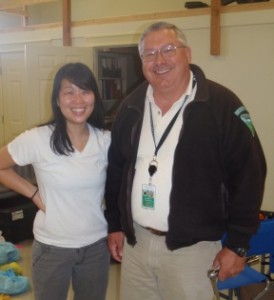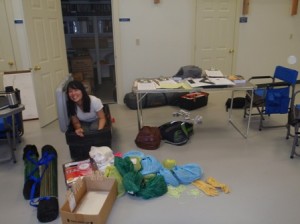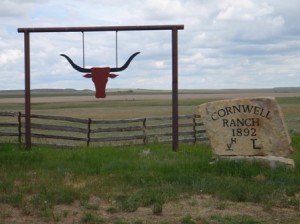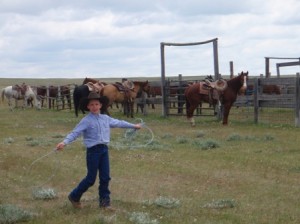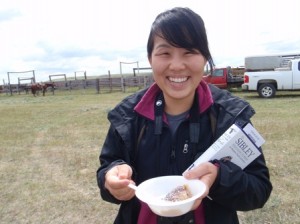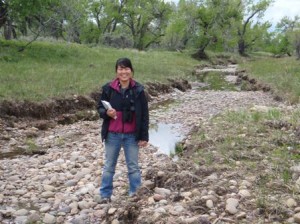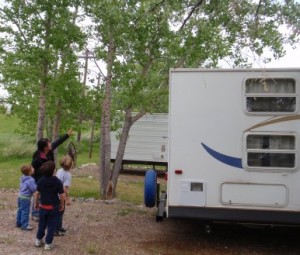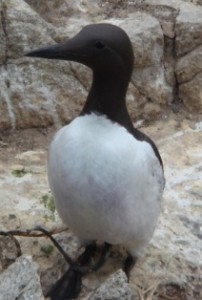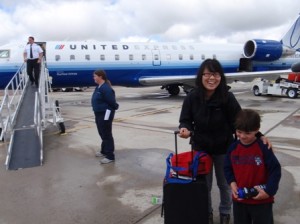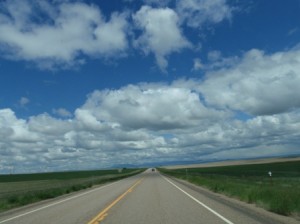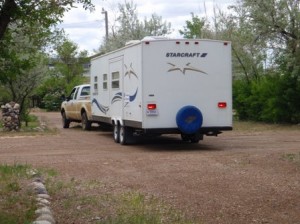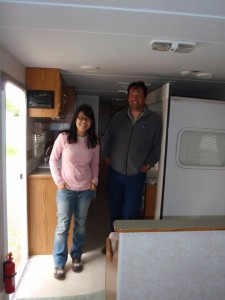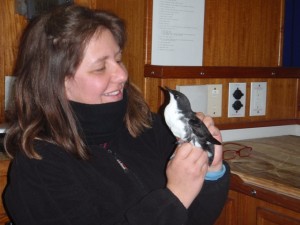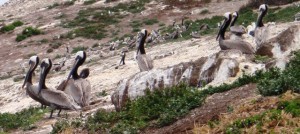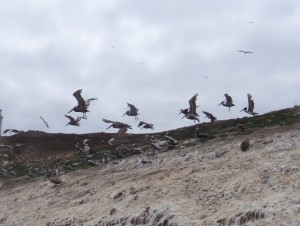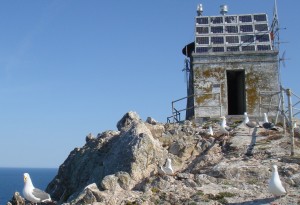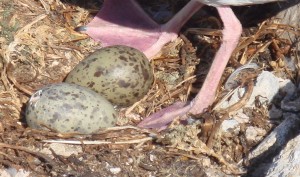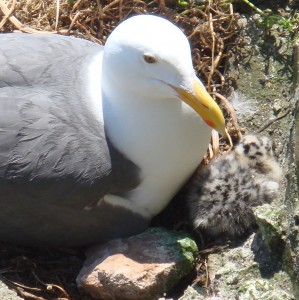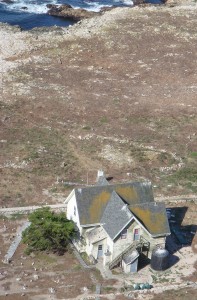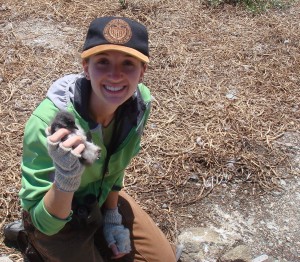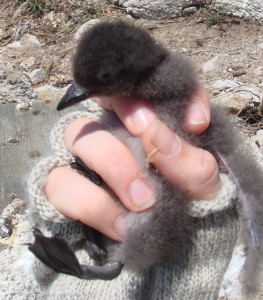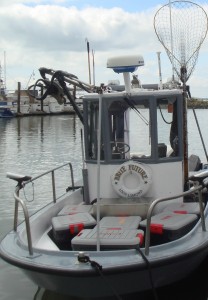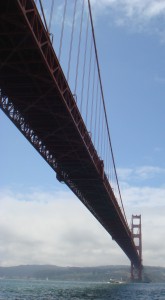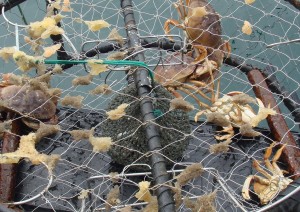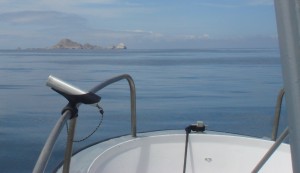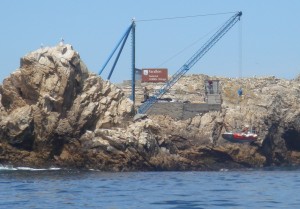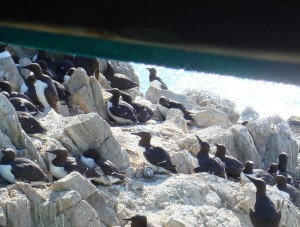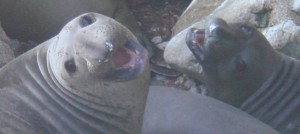SEE THE LAST 2 POSTS FROM CHARLOTTE WITH PHOTOS FROM DR. K.
Posted by: nina-karnovsky | June 10, 2009 | No Comment |Ray to the Rescue!
Posted by: charlotte-chang | June 10, 2009 | 1 Comment |Ray, a range ecologist at the Bureau of Land Management (BLM), has kindly fixed up my trailer—he’s made it so that there is now running water (and heated water), and in general, he helped get it in working order! John, my advisor at the BLM, also did a bunch of work to get the trailer up and running.
I just did my dishes today (although I cooked an awful meal—so if anyone else wants to help me out, send me a few recipes…especially those where I can use zucchini, broccoli, carrots, and/or mushrooms), and I was able to clean up my counter top because I now have running water.
So thanks to Ray! You are awesome, and I look forward to future conversations and hopefully participating in some range assessments.
Nets, nets on the range
Posted by: charlotte-chang | June 9, 2009 | 2 Comments |Amy Briggs (pomona ’10) and I will be running a Monitoring Avian Productivity and Survivorship (MAPS) station and conducting point counts out in Valley County, Montana over the course of the summer. With any luck, the weather will be on the sunnier (i.e. not rainy) side so that we’ll have more time to spend in the field.
A MAPS station is a formal term denoting a bird-banding site supervised by a permit-holding bird bander. Bird banding entails catching a bird in a mist net (a superfine almost invisible net), and subsequently placing a federally-issued numbered metal band on their leg. Because the bird is so close (it’s in your hand!), the researcher can make very detailed assessments about its physical condition. This allows for researchers to track the persistence of different individuals (using the time between recaptures) as well as other population parameters, such as age structure. The Institute for Bird Populations (IBP), U.S. Geological Survey (USGS) jointly administer an online database of bird bands so that recaptures and historical trends can all be analyzed using banding data.
John Carlson, a wildilfe biologist at the Bureau of Land Management, will be supervising our study, and Nina Karnovsky (both are experienced and helpful birders) is our faculty advisor. Nina has been extremely kind; she took the time out of her schedule to come bring me up to Fort Peck, Montana and is staying for a whole week to help set up our project.
We scoped out the study site today–it’s located in a valley at the Cornwell Ranch. The area is more or less ecologically pristine; there has been grazing which helps maintain the prairie but no development (save for a two-lane dirt road). The landscape is absolutely beautiful (think: grassland stream surrounded by cottonwoods, silver sage [which is soft and fuzzy to touch], prairie smoke [a fuschia flower], etc.) and the ranch is still in operation! It’s a cow-and-calf deal, meaning that they raise calves and maintain a population of breeding cows that graze on the surrounding grasslands. And on the real, the place is huge. It took us approximately 20-30 minutes just to drive from the gates of the ranch to the study site.
There were quite a few birds out today, including Western Meadowlark, Yellow Warblers, House wrens, a potential Bullock’s and Baltimore Oriole hybrid (exciting), Upland sandpipers, Long-billed curlews, Western and Eastern Kingbirds (think: Western = casual, Eastern = tux), Barn swallows (awesome), Spotted Towhees, Vesper sparrows, Clay-colored sparrows, McCown’s Longspur, and Chestnut-collared longspur. John heard a Spragues pipit near a cattle pasture but the cows were all mooing too loudly. However, apart from the birds, we saw an even rarer species: cowboys riding HORSES (not two/four wheelers). The group of cowboys ranged from around 3-5 years old to 50+ years old judging from the looks of things. I got to eat some home-made peach cobbler (drenched in half-and-half, interesting) which was cinnamon-flavored gooey tastiness.
The cowboys mentioned that they really appreciate the work that John’s been doing with the local birds because it has further strengthened their commitment to preserving the habitat at their ranch. It also has given them a scientific basis to argue for preserving their land as a site of high avian activity and diversity.
Montana’s short-grass prairie is a rapidly declining ecosystem because of pressures to convert it to cropland and urban development (less of a threat now, but a huge player in areas such as California with our own highly threatened Coastal sagebrush ecosystem). It is a glorious landscape, and Montana isn’t called “Big Sky Country” for nothing–the clouds are so large and so close that it seems like you too could join an American robin hopping by your side and fly into the sky.
Glasgow is semi-rural and even in the trailer park, I’ve seen an abundance of species. So far, the “yard list” comprises: house finches, cedar waxwings, American robins (there’s a nest behind my trailer with at least 2 fledglings!), and Common grackles.
We’re hoping to get the MAPS station up and running by this Friday! Wish us luck, and you can even help us out by thinking “rain, rain go away” (at least until the end of this week). Pictures will either be coming throughout the summer or at the end of August (I think I forgot my uploading cable, whoops).
Shower Day!
Posted by: eleanor-caves | June 9, 2009 | 3 Comments |Here is one of the pictures I meant to put up yesterday. Most of them are of common murres,which are my favorite birds. Their plumage makes them look velvety and clean cut, and they have beautiful dark, expressive eyes. Plus, they have a very goofy way of flying with their feet out behind them, and rather than landing, they tend to sort of crash into things. To top it off, the inside of their mouth is a startling yellow color. Pretty cool! Here is a close-up:
Anyway, today I did more cormorant re-sighting, a little bit of murre counting, some more lid construction adn placement, and then I got to shower! We are on four day rotations for now, and so I will have to wait a little while before my next shower. The only hot running water is located in the Coast Guard House next door. In the house we live in, we have running water, but all of it is cold, so we have to heat water on the stove to do dishes, etc. The problem with showering in the Coast Guard House is that you have to get all dressed up to go outside, just to get to the shower–this means boots, guano protection, and everything. And this is also starting to include hard hat.
As more and more gull chicks hatch, the gulls are getting more and more desparate to protect them, which means swooping down on us fairly frequently. Jordan got pecked in the head today, but I have yet to be actually attacked. I doubt that will last for long, and soon a hardhat will be standard outside issue here.
Today, I also saw a humpback whale, and from the Sea Lion Cove Blind, I got to watch a California Sea Lion give birth to a squishy-looking, dark-skinned pup. Very cute. I also had the dubious pleasure of watching a Western Gull eat one of its own chicks. Very sad…I think it didn’t recognize it, maybe? It is not uncommon for gulls to eat other gull chicks, just not usually their own. They can eat things that are remarkably big compared to them, sometimes swallowing a chick whole.
It’s my turn to cook dinner tomorrow, so wish me luck! I’m pretty tired for now, so I’m off to bed.
Best,
Eleanor
Monday, Monday
Posted by: eleanor-caves | June 8, 2009 | 2 Comments |First, I need to answer the questions about the gloves I’m wearing in the last entry. Almost everyone out here wears them because of a condition many people develop while working out here called Farallon Finger. It can be a fairly serious rash on the hands, but no one really knows what causes it–probably a combination of the plants here, working with the birds, and exposure to the elements. Anyway, wearing fingerless gloves seems to eliminate it, so I am doing so because I’d rather not find out if I am one of those people who is susceptible to it.
So, today was Monday! But, there aren’t weekends of days off here, so everyone just kept on doing their rotations and their duties as usual. This morning, I headed off to the Corm blind (Cormorant Blind) with Claudia, because when she leaves on the next boat, I will be taking over her duties here. In addition to re-sighting banded cormorants (like I did last night), she is also responsible for a plot of murre nest sites.
The studies that are being conducted on Common Murres right now include watching all of the pairs that have nested in a certain plot. Each day, we have to observe them, and ascertain whether they have an egg, or a chick has hatched, or if the chick/egg has died, etc. It’s actually pretty complicated. The blog isn’t letting me upload any pictures right now, so I will check on that and upload the relevant pictures tomorrow.
After lunch, I started on another one of what will be my regular duties–an elephant seal resight project. Every three days I will have to visit three sites on the island where elephant seals are regularly found, checking to see if any of those present are tagged, and recording the tag information if I can. For the most part, watching the seals is really peaceful, because even though they kind of smell, and they make funny noises, and I’m only about ten feet from some very large animals, they have almost no reaction to human presence at all, and they have really beautiful eyes. Watching them is very different from watching disturbed Western Gulls, or any other bird.
Following the elephant seal rounds, Jordan and I helped Pete construct and paint some lids for the auklet boxes that were in my entry yesterday. We are trying to make the manmade boxes more like natural burrows, and some temperature studies they’ve been doing this year show that the boxes are more appropriate for the birds if we place these special extra lids on them.
Finally, I had to go back to the Sea Lion Cove blind to do more cormorant resightings. I was there for about an hour, and watched a lot of birds display and build nests, but there wasn’t much action over there today. Annie and Jordan did, however, see a cormorant nest with an egg in it, far out of any of our study plots, but there nonetheless.
Spotted a female blackpoll warbler in the tree next to the coast guard house today! Also, just got back from playing darts at the Coastguard house with Annie, Claudia, and Pete. Pretty fun stuff.
Finally, an exciting development! Cal Academy of the Sciences has just launched a live webcam from the top of the lighthouse! You can see it by going to :
http://www.calacademy.org/webcams/farallones/
It will be broadcasting live footage 24/7 for as long as it keeps working, so check it out! I might even walk by and wave. Today, we tried it out by focusing it on some pigeon guillemots, a passing whale, and Russ. It’s pretty cool.
Alright, I’ll see what I can do about getting some relevant pictures up.
Best,
Eleanor
Little trailer on the prairie
Posted by: nina-karnovsky | June 8, 2009 | 2 Comments |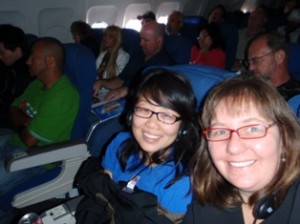
Charlotte and Dr. Karnovsky on an early morning flight to Denver and then they flew onto Great Falls, MT
Yesterday Charlotte Chang’10, Max and I headed off to Northern Montana. Charlotte will be working on a project examining prairie bird diversity and productivity in the shortgrass prairie of northern Montana. This is the third summer a Pomona student has come out here to work on this project. Charlotte is following in the footsteps of Susie Olsen’05 and Sabrina McNew’09.
She has a grant from the Rose Hills Foundation to conduct her research.
Once we arrived we drove for another 6 hours to Fort Peck, MT. On the way we saw deer, antelope, pheasants, meadowlarks, yellow headed blackbirds, willets, trains with more cars than we could count, rain squalls, cows, bison, silos, barns, horses. We played lots of “I Spy with My Little Eye.”
Today was spent getting Charlotte settled into the trailer that she will be living in and posting from for the next 10 weeks. First we had to get the trailer into the trailer park.
John Carlson of the Bureau of Land Management got the trailer positioned and hooked up to electricity.
Next Charlotte and I went food shopping at the local supermarket.
Tune in for updates on Charlotte’s culinary and birding adventures!
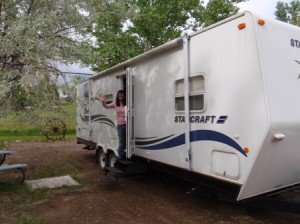
The Elusive Hypoleucus
Posted by: kristen-boysen | June 8, 2009 | 4 Comments |Two subspecies of Xantus’s Murrelets are currently recognized; scrippsi and hypoleucus. These birds look different, make different calls, breed in different places, and recently a genetic test was done to prove they are genetically diverse. Whoever decided they were the same species was a little confused.
The vast majority of the murrelets we saw were scrippsi– they nest on the Channel Islands and usually stay around California throughout the year. Hypoleucus, on the other hand, is much rarer in SoCal, as they nest on the Guadalupe Islands off of Baja. They have a much whiter face and are significantly larger than the scrippsi. It would be a treat to see a hypoleucus! Daryl and Laurie caught just one hypoleucus before we arrived, but we didn’t even see ONE during our spotlighting excursionson SBI. Dr. K had a list of three things she wanted to band: ashy storm petrel (check!), cassin’s auklet (check!) and a hypoleucus murrelet. Alas, we turned back toward Santa Barbara Harbor without one.
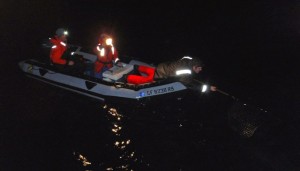
Netting in action! Augie in front with the net, Christie with the spotlight, and Daryl is in back steering the skiff.
After letting Dr. K get back to her academic commitments, Augie and I went with Harry and Daryl to Anacapa Island (more on this later!) to look for murrelet and auklet nests, and also do one more night of captures. There weren’t as many murrelets around Anacapa, but after a slow start, we started to find more and more. All of a sudden, after we had motored down all of East Anacapa Island, Daryl shouted “Hypoleucus!â€. Turns out, it wasn’t just one, but a PAIR of these rare birds right near our boat. Augie, with his master netting skills, managed to catch both birds!! Success! Now, our murrelet education is complete. And Dr. K is very jealous.
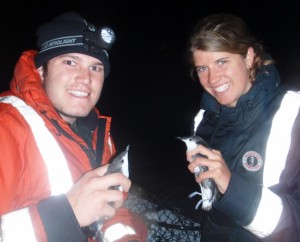
Augie and I with the pair of Hypoleucus murrelets. What a great catch! These birds were far away from their nesting sites in Mexico
However, Dr. Karnovsky and our other lab-mate Charlotte left yesterday for Montana. Hopefully we’ll be getting updates from them soon! In the meantime, Augie and I are preparing for a short trip up to PRBO, in Petaluma, CA. We’ll have missed Eleanor by just a few days!
Tags: Augie, Christie, Daryl, Dr. Karnovsky, hypoleucus, Kristen, Xantus's murrelet
The Beautiful Brown Pelican
Posted by: roy-lagemann | June 8, 2009 | No Comment |We often saw groups of Brown Pelicans flying in formation around both Anacapa and Santa Barbara Island during our voyage. These birds were everywhere! Pelicans prefer to nest on islands that are not inhabited by humans, making Anacapa and SBI prime nesting sites. Though featherless and helpless after hatching, immature Brown Pelicans grow quickly and have been known to consume over 100 pounds of fish and squid while they are being cared for. We often saw mature individuals diving for food near the island (Brown Pelicans are the only Pelicans that do this).
Brown Pelicans have been steadily increasing in number since the 1970’s when they were almost completely wiped out due to high bioaccumulation of organochlorine contaminants, such as DDT and PCBs, in their food supply. Since then, however, their population size has been steadily increasing and the Brown Pelican has since been removed from the California Endangered Species list.
Because Pelicans choose to roost on islands with no predators, they are really only susceptible to human disturbance, including bright lights, noise, fishing activity, and even kayaking and recreational boating. It is now suggested that people stay at least 100 meters from nesting Pelicans to avoid influencing chick abandonment and other negative behavior.
An Introduction
Posted by: eleanor-caves | June 7, 2009 | 6 Comments |Today found me beginning some of my duties, being trained in others, and sometimes simply observing other people. One of Jordan’s responsibilities while she is here will be to conduct the Pelican count every morning, before 9am, from the lighthouse. This can be very difficult–the highest number of Brown Pelicans ever recorded on the island tops 6000, and yesterday, Russ counted about 2500. Since I didn’t have any morning duties today, I went up to the lighthouse with Russ and Jordan, and watched her learn to use the scope. Then, I had about an hour and a half to just stand up at the lighthouse and do whatever I wanted, and it was so amazing.
Visibility today was more than fifty miles, and we could see all the way to Bodega Head, even beyond Point Reyes. I could see the Golden Gate Bridge without binoculars. And, while I was up at the lighthouse, the biggest pod of Risso’s dolphins Russ has ever seen (we estimate about 300) arrived and parked itself in Mirounga Bay, on the West side of the island. The whole time I watched them, they remained, enjoying themselves, and performing complex acrobatics. I also spotted all three of the resident gray whales, watching one of them mosey around the shallows in Fisherman’s Bay for quite some time.
In addition, time at the lighthouse allowed me to observe some of the gulls up there, whose chicks have already begun to hatch.
One gull I found was sitting on an egg which was pipping, meaning its chick was using its egg tooth to begin to crack through the shell:
Other gulls near the lighthouse have already begun to have chicks, and gull chicks are some of the cutest animals on the planet, hands down:
From the lighthouse, you can see everything. A few boats came and went–a sailboat, one fishing boat, and a whale-watching boat. You can see all the foundations of old buildings on the island, and one can do a 360 around the lighthouse to see all of the various islets, gulches, and bays that fringe the island. Finally, you get a great view of our house! Here’s a photo, and the two windows you can see in the upper story (near the staircase) look into me and Jordan’s room:
After the time up at the lighthouse, everyone reconvened at the house to concoct Sunday brunch–a tradition whenever the Sunday schedule allows. Everyone chipped in a dish, and it was delicious. Claudia made bacon; I made scrambled eggs with onions, peppers, and cheese; Pete made waffles; Annie made blackberry sauce for the waffles; Russ made smoothies; and Jordan made some fruit salad.
Following brunch, we all headed out to do a survey of the Cassin’s Auklet chicks on the island, or at least those born to parents of known age. This particular study requires that we weigh the chicks and assess their plumage every five days. The Auklets live, for the most part, in manmade boxes around the island, which allow us easy access to the birds inside.
Auklet chicks are seriously cute animals. By this time of year, many of them are well on their way to having adult plumage. However, some of them are a little behind the rest, and still retain their down, and they weigh only about 50 grams.
This was one of the smaller chicks I pulled out, and he still, almost exclusively, is covered in down. Very soft.
We finished up with the auklet chicks in about an hour, and then I headed to the Sea Lion Cove Blind with Annie to learn how to record re-sightings of Brandt’s cormorants. It’s not a very complicated process, but it can be frustrating, because to read all of the numbers and letters on the band on the leg of a bird who is fifty yards away, you need patience and a really good scope. Sometimes, you can spend fifteen minutes waiting for a bird to shift slightly so you can read the final digit. However, this work is very important, since normally by this time of year, the Cormorants would have nests, eggs, and even some chicks. However, this year, only a handful of nests can be found, and no eggs. The cormorants, who have historically done well here, also had a poor breeding year last year, leading to some concern about their well-being.
I spent more than two hours in the blind, and just got back from that. Annie is cooking dinner right now, and it smells great.
One final unusual sighting, for anyone who likes birds, was that of a Brant Goose, named Molly. Molly’s flock arrived on the island a couple of weeks ago and were picked off one by one. Molly has been attacked by Peregrine Falcons three separate times, and has a limp. However, she is surviving, and I spotted her today, limping around amidst the gulls.
Well, that’s all for today!
Best,
Eleanor
I’m on a Boat!
Posted by: eleanor-caves | June 6, 2009 | No Comment |Today, I made my voyage out to the island, and it was a BEAUTIFUL day.
Our day started around 7:00, when we got up in time to finalize packing the vehicles, eat breakfast, and rendezvous with our skipper, Jared, in Petaluma. Caravan-style, we all drove down to Loch Lomond in San Rafel, where we found our boat, the Brite Future, waiting for us, along with first mate Noah.
The Brite Future is a twenty-five foot fishing and crabbing boat, which takes whale-watching passengers on the side. Today, Jordan and I were its only passengers. We headed out from the dock around 10:30, and travelled past Alcatraz and under the Golden Gate Bridge.
After passing under the Bridge, we headed out onto a notoriously rough stretch of water known as the Potato Patch. (According to Skipper Jared, this is because, years ago, a potato barge capsized whilst crossing this stretch of water.) However, today, we really lucked out, and the water was as smooth as glass–the whole ride felt more like being on a lake than out in the ocean. We motored at around 20 knots for about an hour, and then came across one of Jared and Noah’s buoys, marking their crab traps, so we hauled it up. There were several crabs in the cage, but none were “keepers,” since all of them were female.
Â
Â
Â
Â
Â
Â
Â
After pulling up the trap, it was only about another hour, still on calm seas, out to the islands. As we got closer and closer, seabird and seal sightings became more and more common. My first glimpse of the islands was beautiful, since the sun was out and casting the ocean in a fabulous bright blue color.
Right when we pulled in close to East Landing, one of the Island’s resident gray whales (of which there are three) surfaced only about a hundred feet from us, and continued to swim back and forth near to the island during the entire unloading process. In addition, a pod of Risso’s dolphins played around for about five minutes while we watched.
Getting on to the island is no simple process. To do so, we tied up the Brite Future at a buoy some ways off shore. Then, Russ picked us up in the Zodiac, onto which we loaded our stuff, taking four trips to get everything on and off the island that needed to be transported. There isn’t, however, a dock, so the zodiac has to be lifted straight up into the air using a crane system that has been in place on the island since the 1980’s. It’s a little hard to explain, so here’s a picture:
Â
As I said, it took four trips to get all our stuff onto the island, and it was all loaded onto a cart that waits near the dock. After we got on the island, we pushed the carts to the house and spent an hour putting all the groceries away carefully, so as to keep the produce fresh for as long as possible. Then, famished, we all ate lunch. There are six of us here right now: Jordan, myself, Russ and Pete (the biologists), and two other female interns, Claudia and Annie.
After lunch, Jordan and I moved into our room, which we are sharing. We are in the walk-in room, so named because it is clearly designed to be the room that everyone else walks through to get to their rooms. However, some curtains have been put up to separate our two beds, dresser, and lazy-boy chair from everyone else, and it’s really kind of cute.Â
Once we had moved in, Russ gave us a tour of the house, and together, he, Jordan and I walked down to the other landing, at the North end of the island. On the way we stopped to look at birds, elephant seals, and other things. I even saw a tufted puffin! It was Russ’ night to cook dinner, so we headed back to the house a little early. He made a delicious coconut curry with vegetables, and banana bread for after. So good. After dinner, we filled out the daily log, which I will write more about later. Here are a few quick pictures, and then I’m off to bed.

